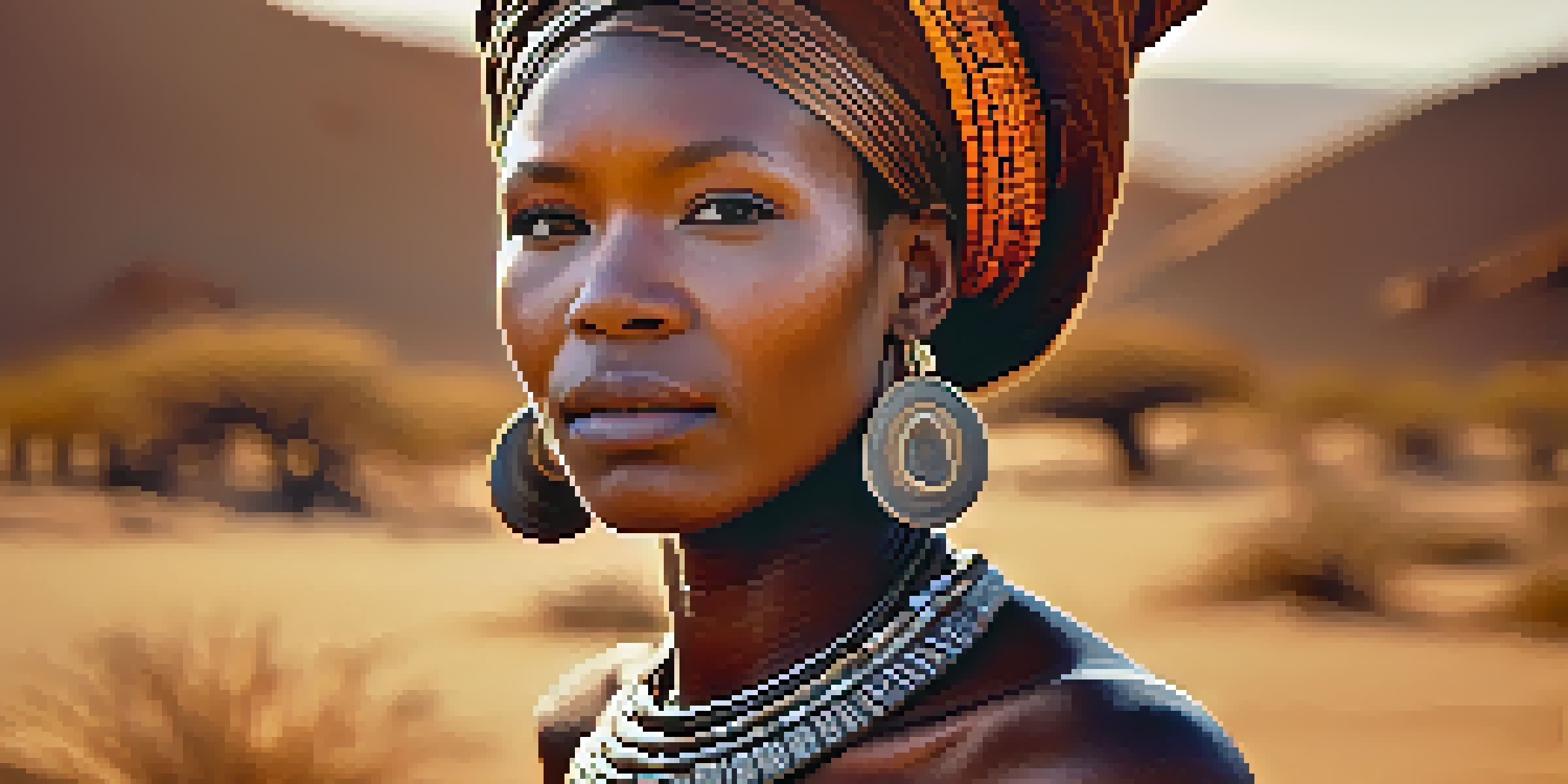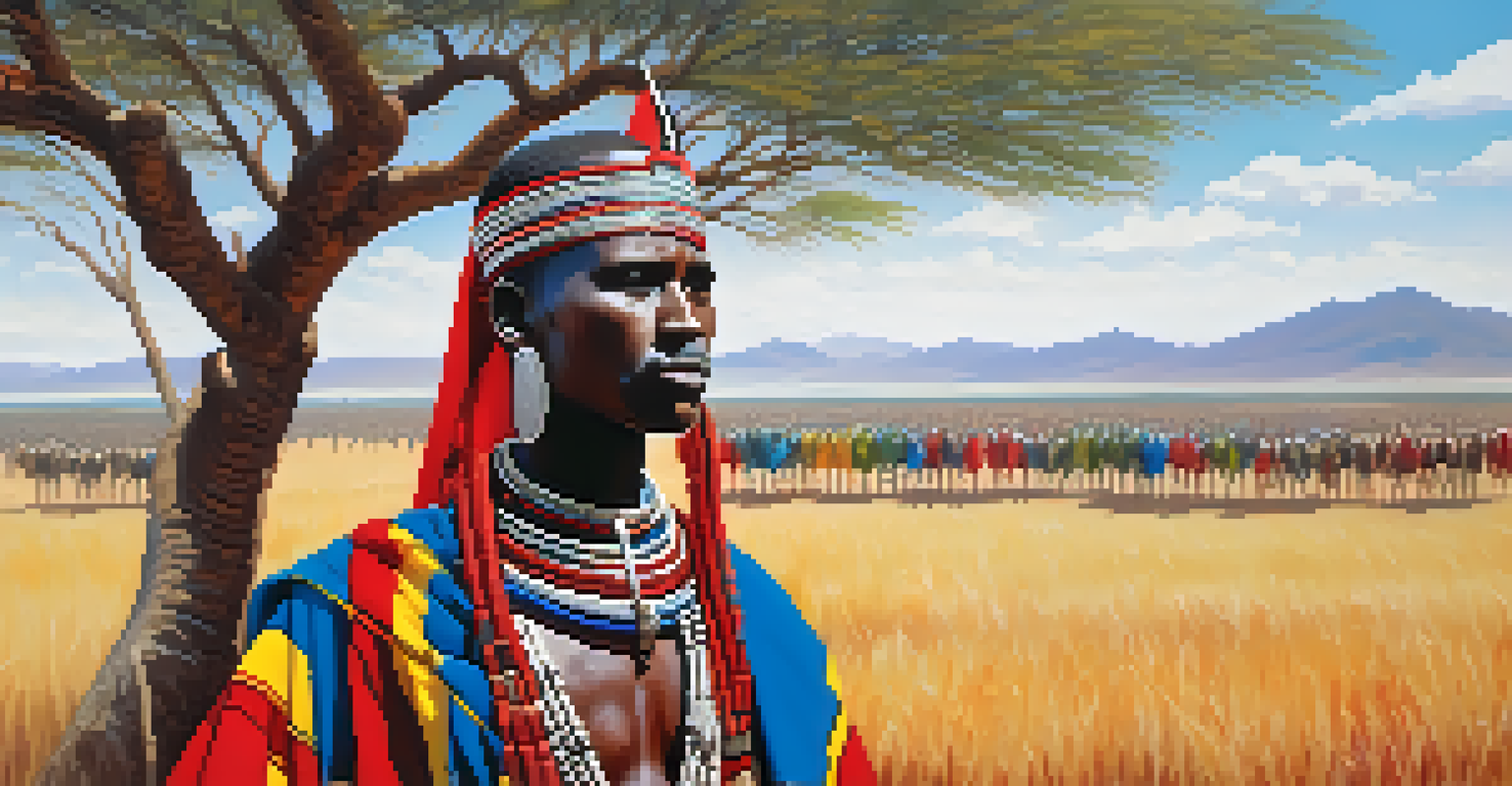Body Painting in Africa: Cultural Significance and Traditions

Understanding the Roots of Body Painting in Africa
Body painting in Africa is a vibrant form of artistic expression with deep cultural roots. Historically, it has been used for various purposes, including religious ceremonies, rites of passage, and social events. Each design, color, and pattern typically carries specific meanings related to the individual's identity and community.
Art is a universal language that transcends borders and cultures, and body painting is one of the most vivid expressions of this language.
In many African cultures, body painting is not just about aesthetics; it embodies spiritual beliefs and cultural narratives. For instance, the use of certain colors can symbolize various emotions or statuses within a community. This highlights how body art serves as a visual language, communicating messages that words sometimes cannot.
Moreover, the tradition of body painting has been passed down through generations, with techniques and meanings evolving over time. Contemporary artists may blend traditional methods with modern influences, creating a dynamic dialogue between past and present. This evolution reflects the adaptability of African cultures while preserving their rich heritage.
Cultural Significance of Body Painting in Different Tribes
Various tribes across Africa have unique approaches to body painting, each reflecting their distinct cultural practices. For example, the Himba people of Namibia are renowned for their use of otjize, a mixture of butterfat and ochre, to adorn their skin. This not only protects their skin from the sun but also signifies beauty and social status.

Similarly, the Maasai tribe in Kenya and Tanzania uses body painting during important ceremonies, such as initiations and weddings. The colors and patterns chosen can represent the individual's achievements and their role within the community. This practice reinforces social bonds and cultural identity among tribe members.
Cultural Significance of Body Painting
Body painting in Africa serves as a vital form of artistic expression that reflects cultural identity and social status across various tribes.
In West Africa, the Yoruba people employ body painting during festivals and religious ceremonies, using intricate designs that often tell stories of deities and ancestors. These artistic expressions serve as a powerful medium for cultural storytelling, weaving the past into the present and strengthening communal ties.
Materials and Techniques Used in African Body Painting
The materials used for body painting in Africa are as diverse as the cultures themselves. Natural pigments, such as ochre, charcoal, and clay, are commonly used, reflecting a deep connection to the land. These materials provide a sustainable way to create art that is both beautiful and culturally significant.
Body painting is not merely decoration; it is a vital part of our heritage and a mirror reflecting our identities.
Techniques can vary widely, with some artists using brushes, while others apply paint directly with their fingers. The process can be a communal activity, with family and friends coming together to create intricate designs. This communal aspect reinforces the social fabric of the community, making body painting a shared experience.
Moreover, the designs themselves can be temporary or permanent, depending on the occasion. For festivals or rituals, the designs might be washed away after the event, symbolizing the fleeting nature of life. In contrast, some people may choose to have more permanent designs that reflect their identity and spirituality, showcasing their pride in their heritage.
Body Painting as a Form of Identity and Expression
Body painting serves as a powerful form of identity and self-expression for many Africans. It allows individuals to showcase their cultural heritage and personal stories through artistic designs. Each painting can reflect one’s social status, age, or achievements, making it a deeply personal form of art.
In recent years, there has been a resurgence of interest in traditional body painting as a way to celebrate African identity in a globalized world. Many young artists are reclaiming this art form, using it to challenge stereotypes and promote cultural pride. This movement highlights the importance of preserving traditional practices while embracing contemporary influences.
Challenges to Traditional Practices
Globalization and environmental issues pose significant threats to the preservation of traditional body painting practices in Africa.
Additionally, body painting has gained international recognition, with artists showcasing their work in galleries and exhibitions around the globe. This exposure not only enriches the global art scene but also fosters a greater appreciation for the cultural significance of body painting in Africa.
The Role of Body Painting in Rituals and Ceremonies
Rituals and ceremonies are often marked by the use of body painting, which adds a layer of significance to these important events. For instance, during initiation ceremonies, young members of the community are painted to symbolize their transition into adulthood. The designs can represent their new roles and responsibilities within the society.
In many cultures, body painting is also integral to religious rituals, where specific patterns and colors are believed to invoke blessings from ancestors or deities. This spiritual dimension elevates body painting beyond mere decoration, making it a vital part of the community’s spiritual practices and beliefs.
Moreover, body painting in ceremonies often creates a sense of unity and belonging among participants. When individuals come together, painted in similar designs, it fosters a shared identity and collective experience that strengthens their community bonds. This aspect of body painting underscores its role in reinforcing cultural traditions and social cohesion.
Challenges Facing Traditional Body Painting Practices
Despite its deep cultural significance, traditional body painting practices in Africa face numerous challenges today. Globalization and urbanization threaten to dilute these age-old traditions as younger generations gravitate towards modern forms of expression. The influence of Western culture can overshadow local practices, leading to a decline in traditional artistry.
Additionally, environmental issues, such as deforestation and climate change, impact the availability of natural materials used for body painting. As communities struggle with these changes, the resources needed for traditional practices become scarce, making it difficult to sustain this art form.
Future of Body Painting Trends
The future of African body painting is characterized by a blend of tradition and innovation, with artists embracing modern techniques while honoring their heritage.
However, there is a growing movement among artists and cultural advocates to preserve and revitalize these traditions. Workshops, exhibitions, and community initiatives are being organized to educate younger generations about the importance of body painting. By fostering a renewed interest, there is hope that these cultural practices will continue to thrive.
The Future of Body Painting in Africa
Looking ahead, the future of body painting in Africa appears to be a blend of tradition and innovation. Many contemporary artists are exploring new techniques and materials, infusing traditional designs with modern artistry. This experimentation can attract new audiences and breathe life into age-old practices.
Social media has also played a significant role in revitalizing interest in body painting. Artists can now showcase their work to a global audience, promoting cultural awareness and appreciation. This platform allows them to connect with others who share similar passions, creating a vibrant community of body painting enthusiasts.

Moreover, the increasing focus on cultural heritage and identity in a globalized world may lead to a resurgence of traditional body painting practices. As people seek to reconnect with their roots, body painting can emerge as a powerful tool for cultural expression, ensuring that these rich traditions continue to thrive for future generations.